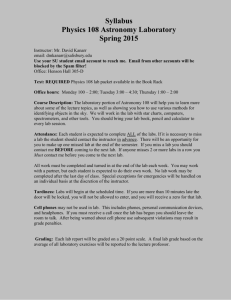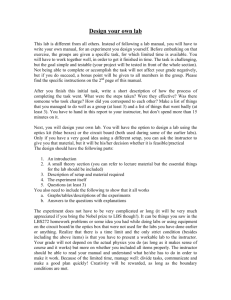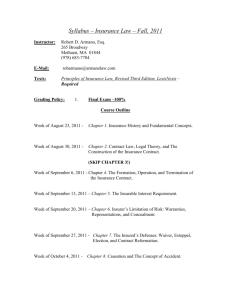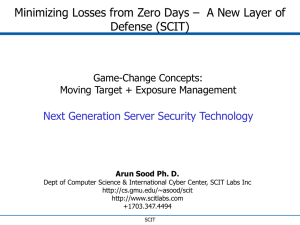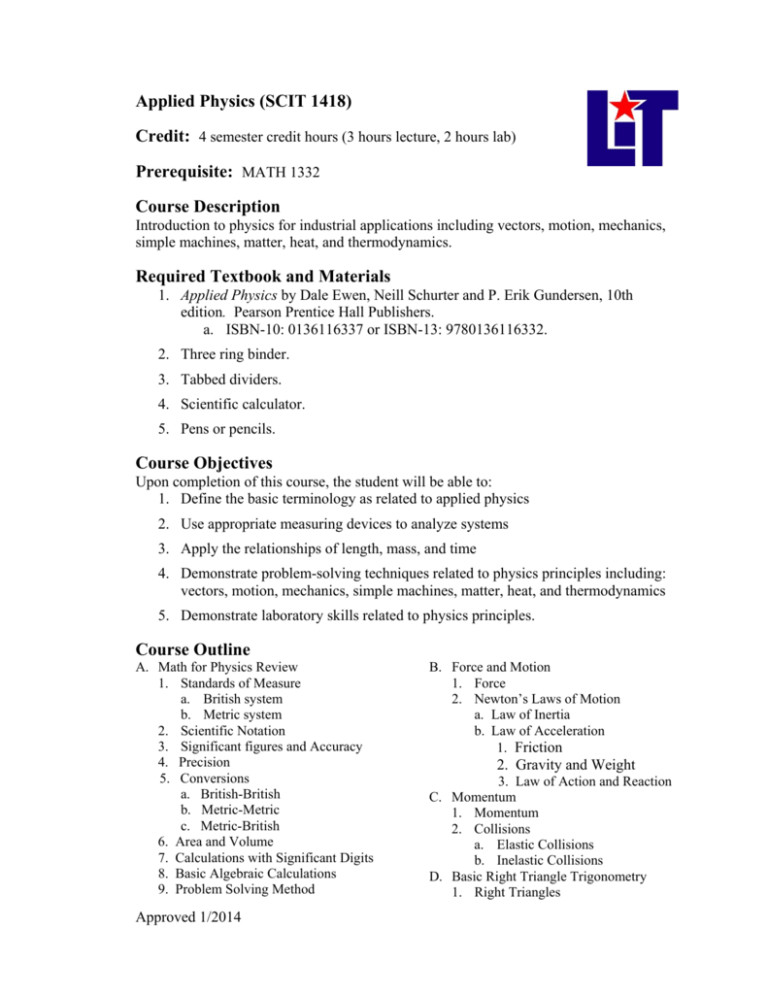
Applied Physics (SCIT 1418)
Credit: 4 semester credit hours (3 hours lecture, 2 hours lab)
Prerequisite: MATH 1332
Course Description
Introduction to physics for industrial applications including vectors, motion, mechanics,
simple machines, matter, heat, and thermodynamics.
Required Textbook and Materials
1. Applied Physics by Dale Ewen, Neill Schurter and P. Erik Gundersen, 10th
edition. Pearson Prentice Hall Publishers.
a. ISBN-10: 0136116337 or ISBN-13: 9780136116332.
2. Three ring binder.
3. Tabbed dividers.
4. Scientific calculator.
5. Pens or pencils.
Course Objectives
Upon completion of this course, the student will be able to:
1. Define the basic terminology as related to applied physics
2. Use appropriate measuring devices to analyze systems
3. Apply the relationships of length, mass, and time
4. Demonstrate problem-solving techniques related to physics principles including:
vectors, motion, mechanics, simple machines, matter, heat, and thermodynamics
5. Demonstrate laboratory skills related to physics principles.
Course Outline
A. Math for Physics Review
1. Standards of Measure
a. British system
b. Metric system
2. Scientific Notation
3. Significant figures and Accuracy
4. Precision
5. Conversions
a. British-British
b. Metric-Metric
c. Metric-British
6. Area and Volume
7. Calculations with Significant Digits
8. Basic Algebraic Calculations
9. Problem Solving Method
Approved 1/2014
B. Force and Motion
1. Force
2. Newton’s Laws of Motion
a. Law of Inertia
b. Law of Acceleration
1. Friction
2. Gravity and Weight
3. Law of Action and Reaction
C. Momentum
1. Momentum
2. Collisions
a. Elastic Collisions
b. Inelastic Collisions
D. Basic Right Triangle Trigonometry
1. Right Triangles
SCIT 1418
Course Syllabus
E.
F.
G.
H.
1. Gears
2. Pulleys Connected With a Belt
I. Matter
1. Properties of Matter
2. Properties of Solids
3. Properties of Liquids
4. Properties of Gases
5. Density and Specific Gravity
J. Fluids
1. Hydrostatic Pressure
2. Pascal’s Principle
3. Air Pressure
4. Buoyancy
5. Fluid Flow
K. Temperature and Heat Transfer
1. Temperature
2. Heat
3. Heat Transfer
4. Specific Heat
5. Calorimetry
6. Change of Phase
L. Gas Laws
1. Charles’ Law
2. Boyle’s Law
3. Gay-Lussac’s Law
4. Combined Gas Law
2. Trigonometric Functions
a. Sine
b. Cosine
c. Tangent
3. Using Trigonometric Functions
a. Determine an Unknown Side
b. Determine an Unknown Angle
Vectors
1. Vectors and Scalars
2. Components of a Vector
3. Addition of Vectors
Concurrent and Parallel Forces
1. Forces in Two Dimensions
2. Concurrent Forces in Equilibrium
3. Torque
4. Parallel Forces
5. Center of Gravity
Simple Machines
1. Machines and Energy Transfer
2. Lever
3. Wheel and Axle
4. Pulley
5. Inclined Plane
6. Screw
7. Wedge
8. Compound Machines
Transferring Rotational Motion
Grade Scale
90 – 100
80 – 89
70 – 79
60 – 69
0 – 59
A
B
C
D
F
Course Evaluation
Final grades will be calculated according to the following criteria:
1. 3 or 4 Unit Tests
50%
2. Comprehensive Final Exam
20%
3. Homework, Class Binder
10%
4. Laboratory
20%
Course Requirements
1. Semester binder containing all handouts, homework, tests, and labs.
2. Laboratory projects.
3. Chapter homework.
2
SCIT 1418
Course Syllabus
4. Unit Tests
5. Comprehensive Final Exam
Course Policies
1. Each unit has assigned homework problems. All homework is due on the testing
day for that unit and must be turned in inside a binder containing dividers as
assigned by the instructor. All calculations must be shown to receive credit.
Completing only odd problems and skipping even problems will result in a grade
of ZERO (0).
2. Makeup work, including labs and exams, may only be made up at the instructor’s
discretion. It is the responsibility of the student to contact the instructor as soon
as possible to arrange for makeup work. All makeup work must be completed
within one week of the original due date.
3. There is a 20 point penalty for work turned in less than one week late. There is a
50 point penalty for work turned in more than one week late, but less than two
weeks late. Work turned in more than two weeks late will not be accepted.
4. Students will not be automatically dropped from the class due to poor attendance
or grades. Discontinuing class attendance without properly submitting a drop
request will result in a failing grade (F).
5. Students are expected to stay for the full duration of the lab period or until all data
is taken, calculations are performed and the lab assignment is turned in. Reports
are to be neat and complete. DO NOT USE RED INK. Corrections should be
made by a single line through the incorrect data and the correction entered next to
the old data. Calculations may be done in pencil, but data should be recorded in
ink.
6. Safety rules must be abided by at all times. Any student who continually breaks
the safety rules will be removed from the class to insure the safety of the other
students in the class.
7. All electronic devices need to be turned off unless prior approval has been given
by instructor to have them set to vibrate. (Permission will only be given in
emergency situations.)
8. Children are not allowed in either the lecture class or laboratory at any time.
9. No food, drinks, or use of tobacco products in class.
10. Attendance in class is vital to understanding physics. If an absence is
unavoidable, arrange with the instructor to attend another session of the class. If
you are absent, it is your responsibility to obtain copies of at least two other
student’s notes and rewrite them in your notebook. If you need further assistance,
please sit up an appointment with the instructor for a tutoring session. Excessive
unexcused absences (per instructor’s discretion) will result in a ten point
deduction from the final semester grade. Attendance in lab is mandatory. Missed
labs may be made up within one week without penalty at the instructor’s
discretion. Labs not made up within two weeks will
3
SCIT 1418
Course Syllabus
result in a grade of zero (0). A lab that is one day to one week late will incur a 20
point penalty. A lab that is more than one week, but less than two weeks late will
incur a 50 point penalty. At the end of the semester, three missed labs (grades of
0) will result in an automatic failing grade (F) for the course.
Disabilities Statement
The Americans with Disabilities Act of 1992 and Section 504 of the Rehabilitation Act
of 1973 are federal anti-discrimination statutes that provide comprehensive civil rights
for persons with disabilities. Among other things, these statutes require that all
students with documented disabilities be guaranteed a learning environment that
provides for reasonable accommodations for their disabilities. If you believe you have
a disability requiring an accommodation, please contact the Special Populations
Coordinator at (409) 880-1737 or visit the office in Student Services, Cecil Beeson
Building.
Course Schedule
Week of
Topic
Reference
Week 1
Chapter 1:The Physics Tool Kit
pp. 1-49
Week 2
Chapter 2:Problem Solving
Chapter 5:Force
pp. 50-67
pp. 128-147
Week 3
Chapter 5:Force, continued
pp. 128-147
Week 4
Chapter 6:Momentum
pp. 148-167
Week 5
Test 1:Chapters 1,2,5,6
Appendix A.5:Right Triangle Trigonometry
pp. 667-673, 685-687
Week 6
Chapter 3:Vectors
pp. 68-97
Week 7
Chapter 7:Concurrent and Parallel Forces
pp. 168-203
Week 8
Chapter 7:Concurrent and Parallel Forces
Test 2:Appendix A.5, Chapters 3,7
pp. 168-203
Week 9
Week 10
Chapter 10:Simple Machines
pp. 266-295
Chapter 9:Rotational Motion
pp. 232-265
Week 11
Chapter 12:Matter
pp. 308-339
Week 12
Test 3:Chapters 10, 9, 12
Chapter 13:Fluids
pp. 340-365
Week 13
Chapter 13:Fluids, cont.
Chapter 14:Temperature and Heat Transfer
pp. 340-365
pp. 366-405
Week 14
Chapter 14:Temperature and Heat Transfer
pp. 366-405
Week 15
Chapter 15:Gas Laws
pp. 406-419
4
SCIT 1418
Course Syllabus
Week 16
Test 4: Chapters 13, 14, 15
Final Exam:Comprehensive
*The instructor reserves the right to make adjustments to this schedule as necessary.
5




